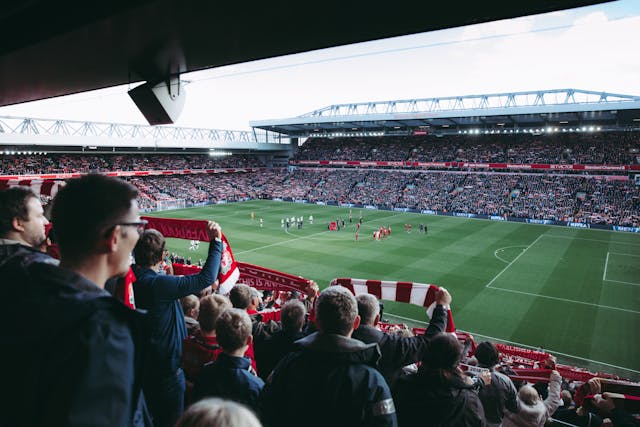Famous Football Chants: The Stories Behind The Lyrics
Football is more than just a game; it’s a culture, a passion, and for many, a way of life.
One of the most iconic expressions of this passion is the football chant. Sung in unison by thousands of fans, these chants echo around stadiums and unite supporters in celebration, frustration, and unwavering loyalty.
But many of these songs didn’t originate in the terraces. They have deeper stories, rooted in regional identity, history, and even folk tradition.
Let’s take a look at some of the most famous football chants and uncover the stories behind their lyrics.
“Blaydon Races” – Newcastle United
Chant:
Oh me lads, you should’ve seen us gannin’
Passing the folks along the road just as they were stannin’
All the lads and lasses there, all with smiling faces
Gannin’ along the Scotswood Road, to see the Blaydon Races
Background:
“Blaydon Races” is not just a chant, it’s a piece of Tyneside heritage. Written by Geordie musician George “Geordie” Ridley in 1862, the song recounts a lively and somewhat chaotic journey from Newcastle to the Blaydon horse races, held on June 9th that year. With its infectious melody and vivid local references, the song quickly became a folk staple across the North East.
Newcastle United fans adopted it as a chant decades ago, and it has since become synonymous with the club and the city.
Sung with pride at St James’ Park, it’s more than a football song, it’s a declaration of local identity and camaraderie.
The lyrics, thick with regional dialect, celebrate the working-class spirit and joy of community, making it a perfect match for Newcastle’s fiercely loyal supporters.
“You’ll Never Walk Alone” – Liverpool
Chant:
Walk on, walk on with hope in your heart
And you’ll never walk alone
You’ll never walk alone
Background:
Originally from the 1945 Rodgers and Hammerstein musical Carousel, “You’ll Never Walk Alone” was covered by Liverpool band Gerry and the Pacemakers in 1963. The song topped the UK charts and was quickly embraced by Liverpool fans.
Since then, it’s become one of the most emotionally resonant anthems in football, also adopted by Celtic and Borussia Dortmund. The chant reflects unity, hope, and resilience with values that transcend the sport.

“Blue Moon” – Manchester City
Chant:
Blue moon, you saw me standing alone
Without a dream in my heart
Without a love of my own
Background:
First penned in 1934 by Rodgers and Hart, “Blue Moon” has been reimagined many times over the years.
Manchester City fans began singing it in the late 1980s and early ’90s, at a time when the club wasn’t enjoying much on-field success. The lonely, almost melancholic tone resonated with City supporters who stood by their team during tough times.
Today, it’s a triumphant chant of loyalty and pride.

“I’m Forever Blowing Bubbles” – West Ham United
Chant:
I’m forever blowing bubbles, pretty bubbles in the air
They fly so high, they reach the sky, and like my dreams, they fade and die
Fortunes always hiding, I’ve looked everywhere
I’m forever blowing bubbles, pretty bubbles in the air
Background:
This early 20th-century American music hall song was adopted by West Ham United in the 1920s, possibly inspired by a local school team whose headmaster was a fan of the song.
The surreal lyrics about dreams fading like bubbles in the air capture the emotional highs and lows of being a football supporter.
Sung before every game at London Stadium, it’s an eerie, beautiful ritual.

“Marching On Together” – Leeds United
Chant:
Marching On Together!
We’re gonna see you win
Na na na na na na
We are so proud
We shout it out loud we love you Leeds! Leeds! Leeds!
Background:
The only chant on this list that was created as a dedicated football song. Originally released in 1972 as the official song for Leeds United’s FA Cup Final appearance, the chant has since become a defining symbol of unity and loyalty among supporters.
With its stirring lyrics and rousing melody, it encapsulates the spirit of the club, through highs and lows, fans and players stand side by side, committed to the club’s journey. More than just a song, “Marching On Together” represents the enduring pride and resilience of Leeds and its footballing faithful.
More Than Just Noise: The Heartbeat of the Game
Football chants are far more than catchy tunes. They are cultural markers that connect fans to their city, their club, and to one another.
Some come from Broadway musicals. Others trace their roots to 19th-century folk songs or chart-topping pop hits. Whatever their origin, they take on new life in the stands and echo across terraces for generations.
Behind every lyric lies a story of pride, passion, and shared identity. These anthems are not just sung; they are lived. And when thousands of voices unite, they become something bigger than the game itself.
**The information provided in this blog is intended for educational purposes and should not be construed as betting advice or a guarantee of success. Always gamble responsibly.

